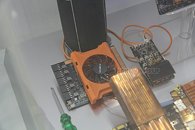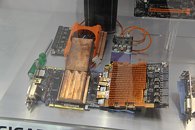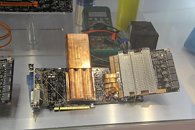- Joined
- Oct 9, 2007
- Messages
- 47,670 (7.43/day)
- Location
- Dublin, Ireland
| System Name | RBMK-1000 |
|---|---|
| Processor | AMD Ryzen 7 5700G |
| Motherboard | Gigabyte B550 AORUS Elite V2 |
| Cooling | DeepCool Gammax L240 V2 |
| Memory | 2x 16GB DDR4-3200 |
| Video Card(s) | Galax RTX 4070 Ti EX |
| Storage | Samsung 990 1TB |
| Display(s) | BenQ 1440p 60 Hz 27-inch |
| Case | Corsair Carbide 100R |
| Audio Device(s) | ASUS SupremeFX S1220A |
| Power Supply | Cooler Master MWE Gold 650W |
| Mouse | ASUS ROG Strix Impact |
| Keyboard | Gamdias Hermes E2 |
| Software | Windows 11 Pro |
Gigabyte showed us its new range of auxiliary VRM boards for graphics cards, designed for professional overclockers. The board has to be manually soldered onto your graphics card, it supplements your card's GPU power domains. The card features a high-current power stage, which draws power from five 8-pin PCIe power connectors. The power stage is actively cooled by a fan-heatsink. While your GPU may never need that much power, it makes near darn sure that it doesn't suffer from voltage droop, which destabilizes your record-seeking OC. Such devices have been attempted by other VGA makers in the past, famously, the EPower Board by EVGA. The company also showed off its first liquid-nitrogen evaporators for GPUs.



View at TechPowerUp Main Site



View at TechPowerUp Main Site



